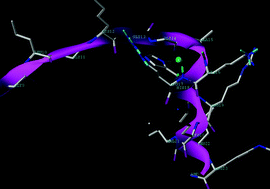Nickel binding to histone H4†
Abstract
Nickel compounds influence carcinogenesis by interfering with a variety of cellular targets. It has been found that nickel is a potent

* Corresponding authors
a
Department of Chemistry & Pharmacy Faculty, University of Sassari, via Vienna 2, Sassari, Italy
E-mail:
zoroddu@uniss.it
Fax: 079-229559
Tel: 079-229529
b Dipartimento di Chimica Generale, University of Pavia, via Taramelli 12, Pavia, Italy
c Department of Environmental Medicine and Kaplan Comprehensive Cancer Center, New York University School of Medicine, New York, USA
Nickel compounds influence carcinogenesis by interfering with a variety of cellular targets. It has been found that nickel is a potent

 Please wait while we load your content...
Something went wrong. Try again?
Please wait while we load your content...
Something went wrong. Try again?
M. A. Zoroddu, M. Peana, S. Medici, L. Casella, E. Monzani and M. Costa, Dalton Trans., 2010, 39, 787 DOI: 10.1039/B916019C
To request permission to reproduce material from this article, please go to the Copyright Clearance Center request page.
If you are an author contributing to an RSC publication, you do not need to request permission provided correct acknowledgement is given.
If you are the author of this article, you do not need to request permission to reproduce figures and diagrams provided correct acknowledgement is given. If you want to reproduce the whole article in a third-party publication (excluding your thesis/dissertation for which permission is not required) please go to the Copyright Clearance Center request page.
Read more about how to correctly acknowledge RSC content.
 Fetching data from CrossRef.
Fetching data from CrossRef.
This may take some time to load.
Loading related content
